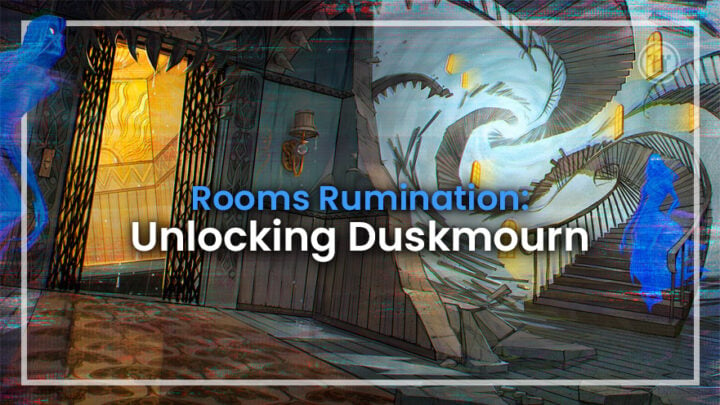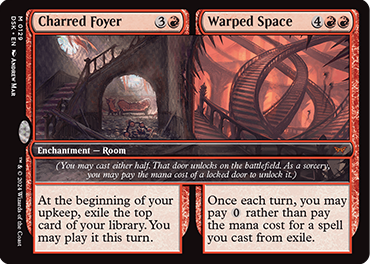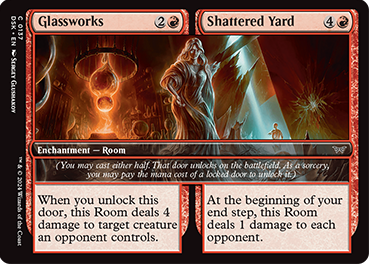The unveiling of new set mechanics is always my favorite part of spoiler season, since their quality has a huge impact on how we perceive that expansion. The new rules need enough flavor and novelty value to turn heads, but also to be balanced, and offer interesting play patterns that can hold up over the next 2-3 years of Standard.
Luckily for the Duskmourn: House of Horror design team, “new” doesn’t always have to mean “reinventing the wheel”. The new “Rooms” spells are just another tweak on the familiar concept of split cards – the biggest difference being that both halves are enchantments!
How do Rooms differ from other split card mechanics like adventures, MDFCs, aftermath and fuse? And what do the ones we’ve already had revealed suggest about their intended gameplay? Let’s see what’s behind door number one…
UNLOCKING NEW DESIGN SPACE
While split cards may be one of the more common mechanical concepts, having both halves of a Room share a permanent type allows for some unique functionality. Regardless of which of its halves (referred to as “doors”) you choose to pay for when casting a Room, the other door will still be “face-up” on the battlefield – and therefore, potentially accessible!
At any point while the enchantment remains in play, you can pay the printed cost of that second door to “unlock” its abilities and add them to the first door. I would compare it to how adventures allow you to potentially use both halves of the same card, except Rooms allow you to play their halves in either order.
I am seriously impressed by how the designers of Rooms managed to keep their mechanic simple and intuitive despite it doing something quite tricky and unprecedented in the Magic rules. I’m not a judge, but I suspect that for real rules boffins this kind of split-permanent could invoke headaches the way mutate did back in Ikoria. But at least if you’re playing them in Limited or Standard, it seems like a lot of the sharp edges have been pre-emptively filed down for safety. For instance, you only “cast” the room once – unlocking the second door is a “special game action” which just happens to share the same mana cost and timing rules as casting it would.
This changes how Rooms will play with cost reducers and “when you cast” triggers, as well as which effects can counter or prevent you unlocking the second door. However, it’s important to note that this unlocking ability is considered a “special game action” and therefore bypasses the stack completely. It’s the same as the rules for turning a Morph or Disguise creature face-up: any effects which trigger from unlocking the door WILL use the stack and allow opponents to respond as normal, so this ends up sounding scarier than it is in practice.
I do like that using unique terms like “unlock this door” rather than “enters the battlefield” means the triggered abilities of Rooms work as intended even when the permanent is already in play. However, this also means that if your Room enters the battlefield without being cast, it starts out with BOTH rooms “locked” – effectively a blank text box until you pay to unlock at least one of the doors.
Hopefully we now all understand Rooms well enough to avoid such an ignominious fate! In that case, let’s see how the actual Room cards so far revealed are shaping up…
ROOM FOR IMPROVEMENT?
At time of writing we have seen 12 Rooms from the main Duskmourn set, covering a reasonable mix of colors and rarities. Some of the Rooms feature doors with different colors, and there are even a few Rooms which seem to be supporting a Room-centric deckbuilding style.
What’s interesting to me is that the Rooms don’t really seem to share any common pattern to their use. Most of them have a single-use trigger on one half and a more traditional enchantment effect on the other, but a few of the mythic rares double up on the latter kind.
It’s also not consistent which of these abilities is on the cheaper half of the card, or even which half you’re “meant” to use first. But the two effects are at least always synergistic, which should hopefully avoid the situation where only one half of a split card is considered playable, and the other half only exists to complicate mana value calculations. If your deck wants one half of a Room, you can rest assured the other half will be at least situationally valuable to you.
As you might expect, the Rooms with at least one very cheap door look like the ones most likely to find a life outside of Duskmourn Limited. So long as the card presents a consistent use case for one or two mana, then the more expensive door is easily justified as a situational or late game bonus. We can evaluate these Rooms with the same mindset as the Class enchantments from Bloomburrow.
But for other Rooms where both abilities are one-use, or more context-dependent effects, there will likely be a dynamic choice about which order to unlock the doors every time they’re played! These cards do seem to be mostly the ones tuned for Limited, but there’s still plenty of time for some powerful Rooms of this ilk to hit the spoiler list. (I’m personally hoping for a black removal spell or green aggro enabler)!
Lastly, there are some Rooms which very much appear to be either tuned for Commander, or which are perhaps intended to be cheated into play on their expensive side to set off some winning combo sequence.
Yes, you can still potentially cheat the unlock cost and get your effect: so long as your cheating ability says “cast without paying its mana cost” or something similar. That restriction presents a serious obstacle to comboing with expensive Rooms in Standard (as does the negative interaction between split card mana values and mechanics such as cascade). But there are still some clear Day One ways you might try and break these cards: you could use the Hideaway trigger on Collector’s Cage, or just make a ton of surplus mana with something like Growing Rites of Itlimoc.
TIME FOR THE WAITING ROOM
We certainly haven’t seen the last of Duskmourn’s Room cards yet, but I think we have enough information to guess at how the card type in general will perform.
As flexible modal spells which can potentially be used twice for a sort of free card advantage, Rooms are fundamentally powerful and efficient cards. The only factors which could offset their playability are the drawbacks of enchantments in general, and an overly cautious power budgeting from Wizards which leave a lot of Rooms as Limited-only curve-toppers.
Speaking of Limited, I do expect to be navigating two or three Room-centric archetypes once I start working on the Duskmourn Draft guide. There’s an upper limit on how many Rooms you can sensibly play in one Draft (well, unless they’re the red removal Room), but the accompanying support mechanic, eerie, is also written to trigger off any enchantment entering play, like an upgrade of constellation.
That’s extra cool because you won’t need to already be “in Rooms” to start picking up synergistic effects – it seems more likely that everyone will be “in Rooms” at least to some degree whether they like it or not. And really, what could sum up the theme of Duskmourn better than that last statement?

Tom’s fate was sealed in 7th grade when his friend lent him a pile of commons to play Magic. He quickly picked up Boros and Orzhov decks in Ravnica block and has remained a staunch white magician ever since. A fan of all Constructed formats, he enjoys studying the history of the tournament meta. He specializes in midrange decks, especially Death & Taxes and Martyr Proc. One day, he swears he will win an MCQ with Evershrike. Ask him how at @AWanderingBard, or watch him stream Magic at twitch.tv/TheWanderingBard.












